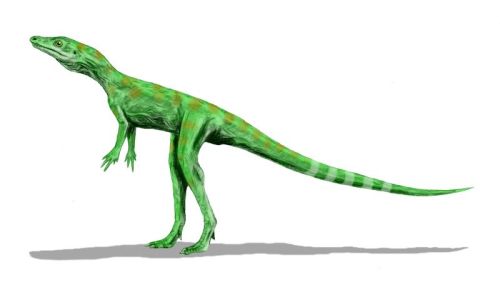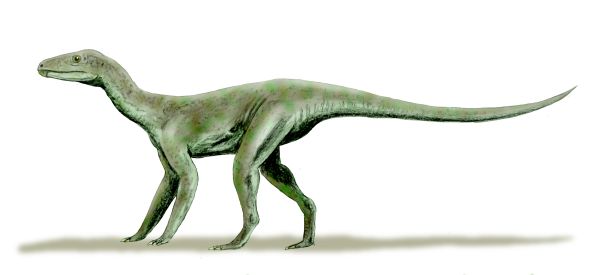Dinosauromorpha
Taxa on This Page
- Dinosauromorpha
- Lagerpeton X
Evolution is an unbroken sequence. Bridging the divide between the thecodontian archosaurs and the first dinosaurs are a number of small, active, lightly built animals, the fossil remains of most of which have only come to light in the last few years. These are the protodinosaurs [1] or paleodinosaurs as Greg Paul refers to them in his early opus Predatory Dinosaurs of the World (although Staurikosaurus which he places in the paleodinosaurs is more properly included with the true dinosaurs). While very much playing second fiddle to their larger and more heavily built crurotarsan contemporaries, the little protodinosaurs would soon give rise to the true dinosaurs, and co-exist alongside them for at least ten million years or more. Their delicate bones would be less likely to be preserve than the heavy skeletons and armour plates of the large phytosaurs and aetosaurs, or the abundant remains of the traversodonts, dicynodonts, and replacing them, prosauropods. So it may well be that these little mesovertebrates were more common and diverse than they appear, and may have played an important role in Triassic terrestrial faunas. The fact that they flourished in a Norian world populated by herrerasaurid and coelophysid dinosaurs means that their extinction was not caused by competition with their very successful offspring, nor did they seme to have been discouriaged by sphenosuchid protocrocodiles, despite the latter being remarkably similar in size, build, and no doubt general appearance. It is more likely that were one of the many victims of the end-Triassic extinction event, although in view of the survival of sphenosuchians into the middle Mesozoic, it may well be that Jurassic protodinosaur remains may one day turn up. For now, these creatures remain one of the more intriguing of Triassic fuanas. MAK120206
[1] Or, as they are more generally referred to, the dinosauriformes or dinosauromorphs. Technically these latter terms designate clades that include birds and dinosaurs as well as protodinosaurs. In order to emphasise the ancestral and transitional nature of these early animals, we have chosen to retain this paraphyletic term.
Descriptions
Dinosauromorpha: Avipes? Birds > pterosaurs.
Primitively, elongated rostrum & numerous small, serrated teeth; cervical column with a strong sigmoid curve; dermal scutes on dorsal midline; long legs (forelimb 50% or less hind limb length); hind-limb carried close to axis of body; inturned femoral head; advanced mesotarsal hinge with joint between astragalus-calcaneum unit and rest of foot; $ astragalus with acute anteromedial corner; $ articular surface of calcaneum for distal tarsals less than 35% of corresponding astragalar articular surface; $ articular facet on distal tarsal 4 for metatarsal V reduced; "hooked" metatarsal V absent; $ metatarsals I & V narrower than II-IV; probably habitually bipedal. Note: See image at Ornithodira. This image shows the primitive state. A dinosauromorph would lack the "hook" on metatarsal V, the calcaneum would be smaller relative to the astragalus, the astragalus would have a sharp corner on the lower left, and so on.
dinosauromorpha; Reptilia.html; dinochar.htm; Marasuchus formerly Lagosuchus); MEA 592D Dinosaur Osteology- Lecture 2; Selected characters for dinosaur groups discussed in this course ...; Dinosaur monophyly Fernando E. Novas, Journal of Vertebrate ...; Dinosaurier-Interesse - Glossar; GEOL 104 Lecture 14- The Origin of Dinosauria; アグノスフィティス・クロムハレンシス; Paleontologia de Argentina - Periodo Triasico. Best on the Web).
Dinosauromorpha is a new site with considerable promise, but not much was posted when we visited 050828). The lecture notes at Dinosaur Origins and MEA 592D Dinosaur Osteology- Lecture 2 have good, concise treatments of the ancestry and characters of the Dinosauromorpha; but no graphics. By contrast, Microsoft PowerPoint - dinolec06.ppt has all the slides, but no text to speak of. Lec 6 Origin of Dinosauria has a bit of both, but focuses on the Dinosauria, rather than their ancestors. Wat is een dino I (moeilijk) is a Dutch translation of an article I wrote a number of years ago focusing on mechanics. I think the English version has (fortunately) been lost. Most of the article was derived from the work of John Hutchison. This, and much more besides, can now be found directly at Adductors, abductors, and the evolution of archosaur locomotion, The evolution of femoral osteology and soft tissues on the line to ..., The evolution of pelvic osteology and soft tissues on the line to ..., and PII- S1095-6433(02)00158-7.
Lagerpeton:
Small (<1m, ~500g), unspecialized ornithodire. Posterior dorsal vertebrae with anteriorly inclined spines; hip generally primitive, wide and short; ilium has wavy dorsal margin; large pubioischiadic "obturator"-type process; femur with square, flat anteromedial surface; astragalus with tongue-shaped posterior ascending process; astragalus and calcaneum co-ossified in adult; digits I & V strongly reduced; digit IV extends further than III; functionally didactyl foot saltatorial?).
Links: DinoData: Lagerpeton; Lagerpeton -- The Dinosauricon; dinosauromorpha.
References: Arcucci 1997). 010324.
checked ATW031023, last revised MAK120206

